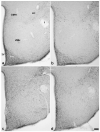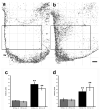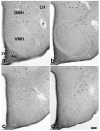Altered position of cell bodies and fibers in the ventromedial region in SF-1 knockout mice
- PMID: 21906594
- PMCID: PMC3214620
- DOI: 10.1016/j.expneurol.2011.08.021
Altered position of cell bodies and fibers in the ventromedial region in SF-1 knockout mice
Abstract
The ventromedial nucleus of the hypothalamus (VMH) is a key cell group in the medial-basal hypothalamus that participates in the regulation of energy balance. Previous studies have shown that the cellular organization of the VMH is altered in mice with a disruption of the steroidogenic factor-1 (NR5a1) gene (SF-1 KO mice). The present study examined orexigenic/anorexigenic peptides (neuropeptide Y (NPY), agouti-related peptide (AgRP) and cocaine- and amphetamine-regulated transcript (CART)) and neural connections to and from the VMH in SF1 KO mice. NeuroVue tracing and Golgi staining were used to evaluate connections between the preoptic area (POA) and VMH and the orientation of dendrites in the VMH, respectively. Results of this study reveal changes in the cytoarchitecture of the region of the VMH with respect to the distribution of immunoreactive NPY, AgRP and CART. In WT mice projections from the POA normally surround the VMH while in SF-1 KO mice, projections from the POA stream through the region that would otherwise be VMH. Golgi impregnation of the region revealed fewer dendrites with ventrolateral orientations and in general, more variable dendritic orientations in SF-1 KO mice providing additional evidence that the connectivity of cells in the region is likely altered due to the cellular rearrangements consequent to disruption of the NR5a1 gene. In conclusion, this study greatly extends the data showing that the morphology of the regions containing the VMH is disrupted in SF-1 KO mice and suggests that changes in the location of cells or fibers containing NPY, AgRP and CART may, in part, account for changes in body weight homeostasis in these mice.
Copyright © 2011 Elsevier Inc. All rights reserved.
Figures







Similar articles
-
Genetic labeling of steroidogenic factor-1 (SF-1) neurons in mice reveals ventromedial nucleus of the hypothalamus (VMH) circuitry beginning at neurogenesis and development of a separate non-SF-1 neuronal cluster in the ventrolateral VMH.J Comp Neurol. 2013 Apr 15;521(6):1268-88. doi: 10.1002/cne.23226. J Comp Neurol. 2013. PMID: 22987798 Free PMC article.
-
Loss of steroidogenic factor 1 alters cellular topography in the mouse ventromedial nucleus of the hypothalamus.J Neurobiol. 2004 Sep 15;60(4):424-36. doi: 10.1002/neu.20030. J Neurobiol. 2004. PMID: 15307147
-
Plasma membrane and vesicular glutamate transporter mRNAs/proteins in hypothalamic neurons that regulate body weight.Eur J Neurosci. 2003 Sep;18(5):1265-78. doi: 10.1046/j.1460-9568.2003.02840.x. Eur J Neurosci. 2003. PMID: 12956725
-
SF-1 in the ventral medial hypothalamic nucleus: a key regulator of homeostasis.Mol Cell Endocrinol. 2011 Apr 10;336(1-2):219-23. doi: 10.1016/j.mce.2010.11.019. Epub 2010 Nov 24. Mol Cell Endocrinol. 2011. PMID: 21111025 Free PMC article. Review.
-
Central nervous system-specific knockout of steroidogenic factor 1.Mol Cell Endocrinol. 2009 Mar 5;300(1-2):132-6. doi: 10.1016/j.mce.2008.09.026. Epub 2008 Oct 5. Mol Cell Endocrinol. 2009. PMID: 18951950 Review.
Cited by
-
Patterning, specification, and differentiation in the developing hypothalamus.Wiley Interdiscip Rev Dev Biol. 2015 Sep-Oct;4(5):445-68. doi: 10.1002/wdev.187. Epub 2015 Mar 27. Wiley Interdiscip Rev Dev Biol. 2015. PMID: 25820448 Free PMC article. Review.
-
Brain nuclear receptors and body weight regulation.J Clin Invest. 2017 Apr 3;127(4):1172-1180. doi: 10.1172/JCI88891. Epub 2017 Feb 20. J Clin Invest. 2017. PMID: 28218618 Free PMC article. Review.
-
Genetic labeling of steroidogenic factor-1 (SF-1) neurons in mice reveals ventromedial nucleus of the hypothalamus (VMH) circuitry beginning at neurogenesis and development of a separate non-SF-1 neuronal cluster in the ventrolateral VMH.J Comp Neurol. 2013 Apr 15;521(6):1268-88. doi: 10.1002/cne.23226. J Comp Neurol. 2013. PMID: 22987798 Free PMC article.
-
Distinct temporal requirements for Sonic hedgehog signaling in development of the tuberal hypothalamus.Development. 2018 Nov 2;145(21):dev167379. doi: 10.1242/dev.167379. Development. 2018. PMID: 30291164 Free PMC article.
-
Evidence that sex chromosome genes affect sexual differentiation of female sexual behavior.Horm Behav. 2012 May;61(5):719-24. doi: 10.1016/j.yhbeh.2012.03.008. Epub 2012 Mar 30. Horm Behav. 2012. PMID: 22483977 Free PMC article.
References
-
- Brobeck JR. Mechanism of the development of obesity in animals with hypothalamic lesions. Physiol. Rev. 1946;26:541–559. - PubMed
-
- Broberger C. Hypothalamic cocaine- and amphetamine-regulated transcript (CART) neurons: histochemical relationship to thyrotropin-releasing hormone, melanin concentrating hormone, orexin/hypocretin and neuropeptide Y. Brain Res. 1999;848:101–113. - PubMed
-
- Broberger C, Visser TJ, Kuhar MJ, Hokfelt T. Neuropeptide Y innervation and neuropeptide-Y-Y1-receptor-expressing neurons in the paraventricular hypothalamic nucleus of the mouse. Neuroendocrinology. 1999;70:295–305. - PubMed
Publication types
MeSH terms
Substances
Grants and funding
LinkOut - more resources
Full Text Sources
Molecular Biology Databases
Research Materials
Miscellaneous

